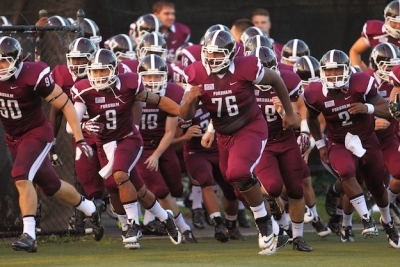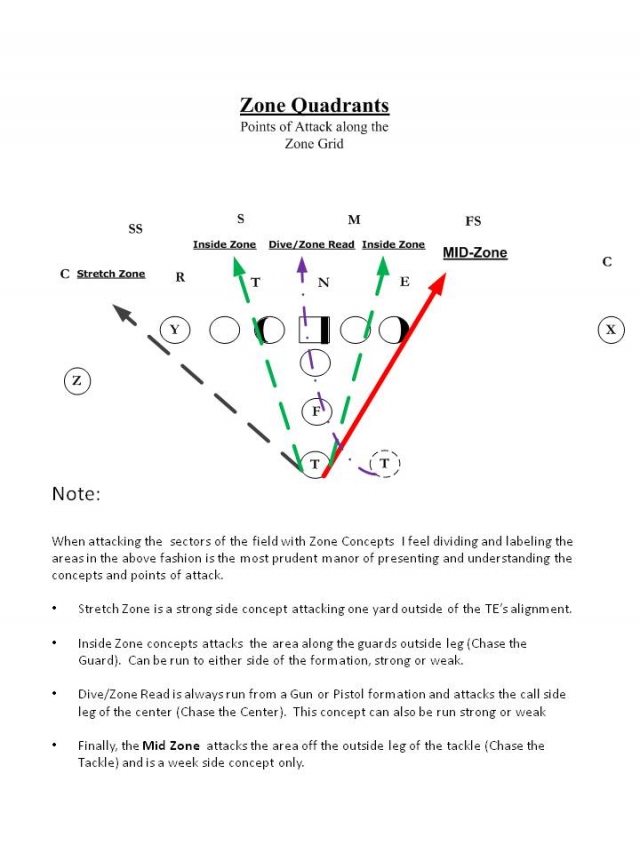By Mike Kuchar
Senior Research Manager
X&O Labs
Twitter: @MikekKuchar
Introduction
 While the middle zone continues its advancements among the football ranks, we found it imperative to research what were the most efficient fronts to run it against and how offensive line coaches were teaching their players to run it. We focused our research on alleviating some of the more common problems when utilizing the middle zone scheme, including blocking a play side 3-technique, blocking a play side shade and how to correctly teach the combination blocks at the point of attack.
While the middle zone continues its advancements among the football ranks, we found it imperative to research what were the most efficient fronts to run it against and how offensive line coaches were teaching their players to run it. We focused our research on alleviating some of the more common problems when utilizing the middle zone scheme, including blocking a play side 3-technique, blocking a play side shade and how to correctly teach the combination blocks at the point of attack.
Packaging the Play
John Donatelli, the offensive line coach at Towson University, talks to his offensive linemen about a pre-snap thought process that surrounds each of the schemes he runs. “In order to execute what I call a proper ‘pre-snap cerebral process,’ linemen must walk themselves through a few simple questions before the snap of the ball,” Coach Donatelli told us. “We have found that this approach has a variety of benefits. Understanding the play concept completely allows linemen to truly get an understanding before the snap of the ball as to how the defense will react to and fit the play. We are able to push our players far past their particular assignment and deepen their knowledge. We have found that this approach speaks to the individual player’s knowledge of the play and gives them a process to understand how their role in the scheme is impacted by those around them.”
This is the progression that our players here at Towson work through each play and the benefits of each individual question in Coach Donatelli’s words.
What is the play’s point of attack?
“We teach our players that this process starts with understanding “attack point” of the play. This forces the player to take his assignment to be more than just a line on a page. Instead, he is forced to determine how he can execute his assignment to enhance our team’s ability at the point of attack.”

What is the alignment of the defenders?
“Analyzing the alignment of the defenders pre-snap is crucial to success. For us, that means taking account for more than just the defender lined up over him. We teach our players that they also must process how the two hard defenders to his right and left are aligned.”
Examples are below:
- OT Alignment Keys: Includes the DE and DT or NT
- OG Alignment Keys: Includes the NT and DT or DE
- C Alignment Keys: Include the DT and NG
“In each case, the linemen will assess the width of each defender in regards to how tight or lose in alignment they are. The linemen must be trained to then turn their attention to the alignment of the LB over him. When assessing the linebacker, the lineman must be sure to account for both the width and depth of LB’s position.
Assessing these three points will provide the lineman with a base understanding of what could possibly be occurring on the other side of the ball. In order to further his knowledge of the defense, the player must take his assessment to the next level and process more than just those three points, two hard defenders and one linebacker.
Once they get a handle on understanding those three points, we teach our players to assess their entire half of the defense. This would mean reading the pre-snap alignment of all the hard defenders (including opposite NG for the guards), linebackers and safeties on their side of the ball. Each individual lineman’s ability to process the alignment of these defenders will unlock the defense’s intentions (most of the time), giving your linemen the advantage.”
What can the defenders do from that alignment?
“After processing the alignment of the defenders, linemen will have a very good understanding of what the movement or pressure the defense is about to employ on any given play. At this point, the alignment information will converge with what each lineman has learned through the week of preparation and film study. In most cases, our players will have a very good idea what tactic the defense is about to employ based on the details of the alignments against our particular formation. This information helps the player make decisions about what tools to use (next step). The best part of this process is that over time we see our linemen being able to apply this knowledge of defensive structures on the fly. In some cases, they not need much specific film study to understand by pre-snap alignment what the defense is about to do. When your lineman get to that point, your offense is going to be able to able to adjust to almost anything in game situations.”









